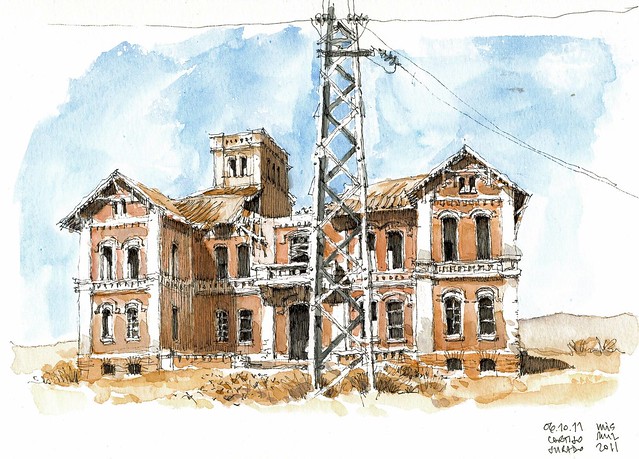
Edipo, en pie frente a la esfinge en Tebas, es interpelado por ésta: «¿cuál es el ser vivo que camina a cuatro patas al alba, con dos al mediodía y con tres al atardecer?» Ya sabemos que Edipo interpretó correctamente que la respuesta era el hombre, pero también intuimos que esa pregunta oculta otros misterios más insondables relacionados con el paso del tiempo.
Me encuentro en completa soledad, frente a una vieja mansión arruinada enclavada en una desolada y ventosa colina desprovista de toda vegetación. Con la excepción de la calavera de Yorick, ninguna otra imagen nos ilustra con mayor elocuencia lo fugaz de nuestra existencia que esos viejos muros calcinados por el sol, a través de cuyas ventanas desnudas hace ya mucho que se disipó la calidez familiar que un día lejano albergaron. Los lares ya no habitan allí.
Mientras dibujaba la ruina en completo ensimismamiento, la esfinge, transmutada en caserón hopperiano, me habló. Me recitó una cuarteta de Jayyám:
El incierto mañana nunca nos pertenece.
Goza del hoy. y bebe a la luz de la luna,
de esa luna que en vano, milenio tras milenio,
nos buscará fielmente para darnos su brillo.
Oedipus, standing in front of the Sphinx in Thebes, is challenged by her: "What is the living being that walks on four legs at dawn, two at noon and three at dusk?" We know that Oedipus correctly interpreted that the answer was the man, but we suspect that this question hides other unfathomable mysteries connected with the passage of time.
I am in complete loneliness, facing a ruined old mansion set in a bleak and windy hill devoid of all vegetation. With the exception of the skull of Yorick, I can hardly think of any other picture that would more eloquently illustrate the fugacity of our existence than those old walls scorched by the sun; through its now bare windows the family warmth that one distant day it housed has gone since. The Lares no longer live there.
While drawing the ruins in total reverie, the Sphinx, transmuted into hopperesque mansion, spoke to me. She recited a quatrain of Khayyam to me:

además de dibujar, escribes como los angeles
ResponderEliminarun abrazo
Poesia dibujada,
ResponderEliminarPoesia escrita,
Enhorabuena, Luis!
Josu, Filipe, ¡muchas gracias a los dos!
ResponderEliminarLujazo de dibujos, y bella realidad la del poema, Luis:
ResponderEliminar"El incierto mañana nunca nos pertenece.
Goza del hoy...."
Así es....
Un abrazo!
Pues sí, Anais. Hay que vivir el presente... Un abrazo.
ResponderEliminarDear Luis, these sketches are masterly drawn as usual, but they have something special for me as they reflect my mood in this beginning of autumn. You have found much more than half ruined walls in these abandoned buildings, you have found a powerful metaphore.
ResponderEliminarLuis, son unos dibujos magníficos todos los que veo en tu blog : )
ResponderEliminar